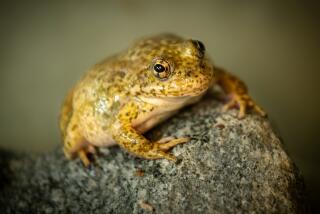Found: the only known frog to give birth to live tadpoles
- Share via
In one of the tallest rain forests in the world, scientists have discovered a fanged frog that gives birth to live tadpoles. Of the 6,455 known species of frogs on our planet, it is the only one to exhibit this particular behavior.
The newly named frog was found in small puddles and side streams in a rainforest in Sulawesi Island in Indonesia. It’s a small animal, about 1.5 to 2 inches long.
In a paper in PLOS One describing the tadpole-bearing frog, an international research team named it Limnonectes larvaepartus, which means “giving birth to an early form of an animal.”
They first realized it could give birth to live tadpoles when UC Berkeley herpetologist Jimmy McGuire was trying to take a liver sample of a female frog. He cut into the frog’s abdomen, and, unexpectedly, a few dozen tadpoles slipped out.
“We had captured some of them and at the time, we didn’t even know what they were,” he said. “Then we opened one up and out popped all these squirming tadpoles.”
Another time he thought was picking up a male frog when out came a handful of the tiny tadpoles less than half an inch long.
“I was trying to catch them so we wouldn’t lose any,” said McGuire. “We wanted to know the clutch count.”
Over 13 years of studying these frogs, McGuire and his colleagues witnessed 19 different instances of females either carrying or giving birth to live tadpoles.
The research team is still not sure what mechanisms the frogs use to fertilize the eggs in the females’ oviducts. They have not found a penis-like organ on the male, and they have yet to see the L. larvaepartus mate in the wild.
In a typical frog life cycle, the male calls to the female, and when she arrives, grabs her either around the waist or under the armpits. While they’re locked in this embrace, she deposits her eggs and he fertilizes them. The eggs are usually left to develop on their own in the water. Eventually tadpoles come out, and over time, those tadpoles develop into frogs.
Not that it always works this way. Some frogs have evolved to provide their developing young with more protection. For example, the male Darwin’s frog guards his eggs and then, when they become tadpoles, swallows them and keeps them safe in his vocal sac. Only when the tadpoles mature to little froglets does he cough them up and spit them out.
The now-extinct female gastric-brooding frog gobbled up her fertilized eggs and then neutralized her digestive enzymes so her tadpoles could develop in the safety of her stomach.
And you can watch amazing video of several Suriname toad froglets “hatching” out of holes in their mother’s back. Fertilized eggs get deposited on her back, and then her skin grows over them to keep them protected until they are ready to be born.
But despite all this dazzling diversity of reproduction, there are less than a dozen known frogs that have internal fertilization, and only one that gives birth to live tadpoles.
And that’s what McGuire finds truly intriguing about this discovery.
“Something like shutting down your gastrointestinal system seems like a pretty complicated thing for evolution to produce, but giving birth to a live tadpole ought to be easy,” he said. “Why is this the only frog that does it?”
Science rules! Follow me @DeborahNetburn and “like” Los Angeles Times Science & Health on Facebook.







